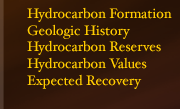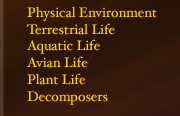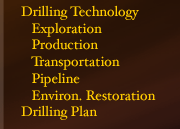
Formation of Hydrocarbons
Types of hydrocarbons
Parameters for hydrocarbon accumulation
Phases of alteration of organic matter
Types of kerogen
Migration of hydrocarbons
Five Major Types of Hydrocarbons
Kerogen: Kerogen is a fine-grained, amorphous organic matter. It is not soluble to normal petroleum solvents, like carbon disulfide. Its chemical compositioin is 75% C, 10% H, 15% other (sulfur, oxygen, nitrogen, etc.). It is very important in the formation of hydrocarbons because it is what generates oil and gas. Source rocks must contain significant amounts of kerogen.
Asphalt: Asphalt is a solid at surface temperatures. It is soluble to petroleum solvents. It is produced by the partial maturation of kerogen or the degradation of crude oil.
Crude Oil: Crude oil is a liquid at surface temperatures. It is soluble to normal petroleum solvents. It has four main groups of organic compounds: paraffin, naphthalene, aromatics, and resins.
Natural Gas: Is a hydrocarbon gas. The major natural gases are methane, ethane, propane, and butane.
Condensates: These are hydrocarbons transitional between gas and crude oil.
Five Parameters for Hydrocarbon Accumulation
- Source rocks are required to generate hydrocarbons. Generally, has
greater than .5% organic matter (kerogen) by weight.
- Reservoir rocks are required to store hydrocarbons.
- Seal or cap rocks are present to prevent the upward escape of hydrocarbons
from reservoir.
- Traps occur where the source, reservoir and seal are arranged in a way
that the hydrocarbons can move from the source to the reservoir.
- Source rock must have been heated sufficiently for oil (greater than 60C)
and gas (greater than 150C)
Three Phases of Alteration of Organic Matter
Diagenesis: Diagenesis occurs at the surface at normal temperatures. The organic matter goes under bacterial decay, oxidation, dehydration and decarboxylation. The resultant is kerogen. The porosity decreases 60% to 40%.
Catagenesis: Temperatures increase to 250C and kerogen generates oil or gas. The porosity decreases to 10%.
Metagenesis: Occurs at 250C right when the kerogen is going to change into oil or gas.
Catagenesis is the most important stage, and is different for the three different types of kerogen.
Type I (Algal): It is very rich in hydrogen, low in oxygen and contains lipids. It generates oil and is present in oil shales.
Type II (Liptinic): It is made from algal detritus, phytoplankton and zooplankton. It has aliphatic compounds and more hydrogen than carbon. It can generate oil or gas.
Type III (Humic): It has more carbon than hydrogen, and is rich in aromatic compounds. It is produced form lignin in higher woody plants. It generates gas.
Type I and Type II are usually found in marine environment and Type III is found in continental environments. That is why there is the generalization that marine produces oil and continental produces gas.
Primary migration of hydrocarbons is the movement of oil and gas from source rock to permeable carrier beds. Secondary migration is the movement from permeable carrier beds to the reservoir beds. Secondary migration occurs through porous rocks due to buoyancy and capillary and regional pressure gradients.





